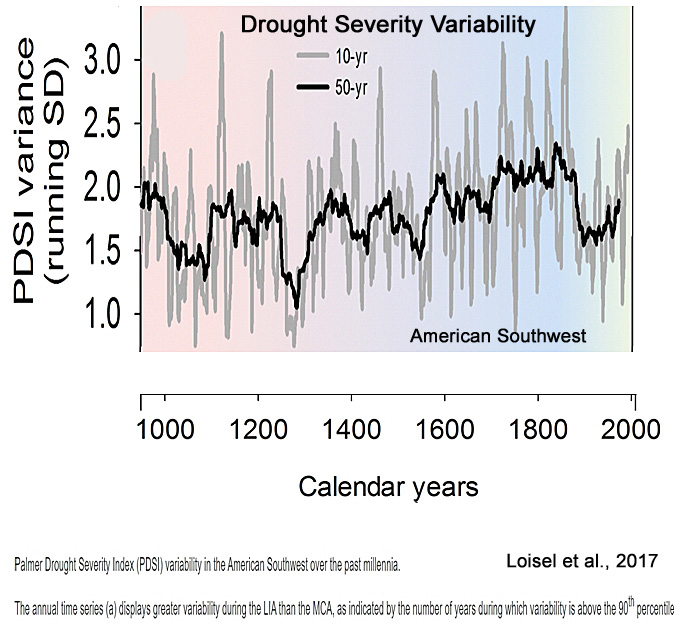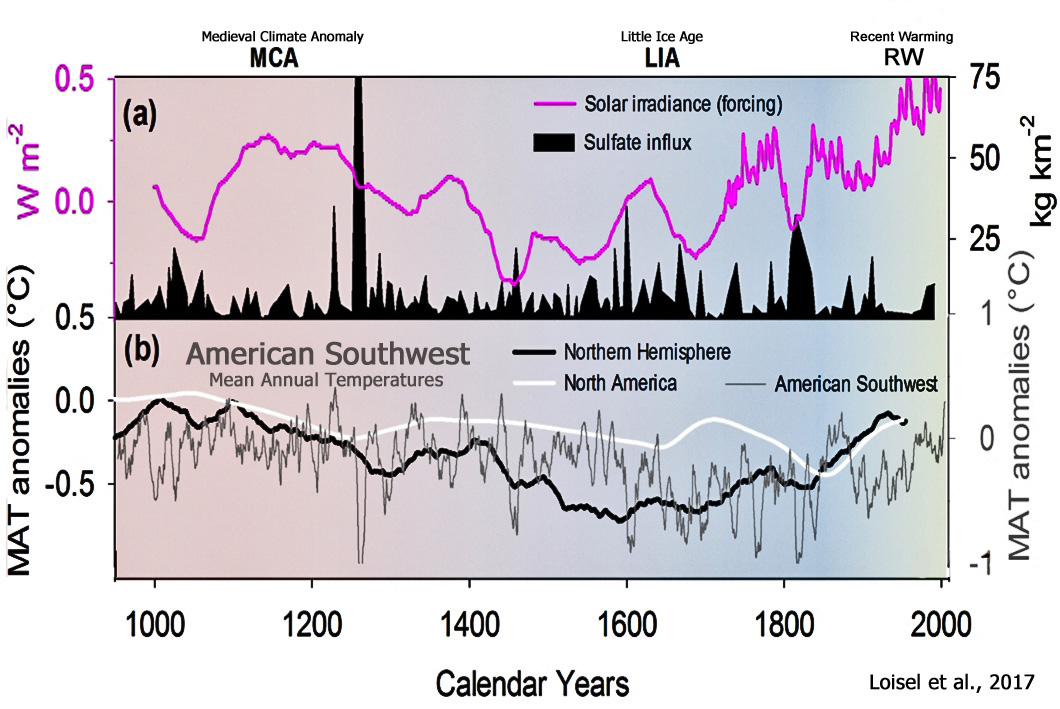Cooling, Not Warming, Leads To
Weather and Climate Instability

Image Source: Loisel et al., 2017
1. Significant Decreasing Trend In Severe Weather Since 1961
Based on continuous and coherent severe weather reports from over 500 manned stations, for the first time, this study shows a significant decreasing trend in severe weather occurrence across China during the past five decades. The total number of severe weather days that have either thunderstorm, hail and/or damaging wind decrease about 50% from 1961 to 2010. It is further shown that the reduction in severe weather occurrences correlates strongly with the weakening of East Asian summer monsoon which is the primary source of moisture and dynamic forcing conducive for warm-season severe weather over China.
2. Most Frequent Climate Instability During Global Cooling/Reduced CO2 Periods
Numerical experiments using a fully coupled atmosphere-ocean general circulation model with freshwater hosing in the northern North Atlantic showed that climate becomes most unstable in intermediate glacial conditions associated with large changes in sea ice and the Atlantic Meridional Overturning Circulation. Model sensitivity experiments suggest that the prerequisite for the most frequent climate instability with bipolar seesaw pattern during the late Pleistocene era is associated with reduced atmospheric CO2 concentration via global cooling and sea ice formation in the North Atlantic, in addition to extended Northern Hemisphere ice sheets.
3. Hurricane Activity Is ‘Subdued’ During Warm Periods (1950-2000)
The hurricane analysis conducted by Burn and Palmer (2015) determined that hurricane activity was subdued during the [warm] Medieval Climate Anomaly (MCA) (~900-1350 CE) and became more produced during the [cold] Little Ice Age (LIA) (~1450-1850 CE), followed by a period of variability occurred between ~1850 and ~1900 before entering another subdued state during the industrial period (~1950-2000 CE). In general, the results of this study corroborate these findings … [W]hile hurricane activity was greater during the LIA, it also had more frequent periods of drought compared to the MCA (Burn and Palmer 2014), suggesting that climate fluctuations were more pronounced in the LIA compared to the MCA. The changes in the diatom distribution and fluctuations in chl-a recorded in this study starting around 1350 also indicate that variations in climate have become more distinct during the LIA and from ~1850-1900.
[C]limate variability has increased following the onset of the Little Ice Age (~1450-1850 CE), however it is difficult to distinguish the impacts of recent anthropogenic climate warming on hurricane activity from those of natural Atlantic climate regimes, such as ENSO.
4. Surface Warming Weakens Cyclone Activity
Results indicate that the midlatitude summer cyclone activity over East Asia exhibits decadal changes in the period of 1979–2013 and is significantly weakened after early 1990s. … Moreover, there is a close linkage between the weakening of cyclonic activity after the early 1990s and the nonuniform surface warming of the Eurasian continent. Significant warming to the west of Mongolia tends to weaken the north–south temperature gradient and the atmospheric baroclinicity to its south and eventually can lead to weakening of the midlatitude cyclone activity over East Asia.
5. More Hydroclimatic Variability During Cold Periods…Models Say Warming Causes More Instability, So The 21st Century Will Be Like The Little Ice Age, With More Instability/Megadrought
Our tree ring-based analysis of past drought indicates that the Little Ice Age (LIA) experienced high interannual hydroclimatic variability, similar to projections for the 21st century. This is contrary to the Medieval Climate Anomaly (MCA), which had reduced variability and therefore may be misleading as an analog for 21st century warming, notwithstanding its warm (and arid) conditions. Given past non-stationarity, and particularly erratic LIA, a ‘warm LIA’ climate scenario for the coming century that combines high precipitation variability (similar to LIA conditions) with warm and dry conditions (similar to MCA conditions) represents a plausible situation that is supported by recent climate simulations. … Our comparison of tree ring-based drought analysis and records from the tropical Pacific Ocean suggests that changing variability in El Niño Southern Oscillation (ENSO) explains much of the contrasting variances between the MCA and LIA conditions across the American Southwest. The Medieval Climate Anomaly (MCA, ~950–1400 CE) is often used as an analog for 21stcentury hydroclimate because it represents a warm (and arid) period. The MCA appears related to general surface warming in the Northern Hemisphere, prolonged La Niña conditions, and a persistent positive North Atlantic Oscillation mode. It has been referred to as a stable time interval with ‘quiet’ conditions in regards to low perturbation by external radiative forcing. In this study, we demonstrate that the Little Ice Age (LIA, ~1400–1850 CE) might be more representative of future hydroclimatic variability than the conditions during the MCA megadroughts for the American Southwest, and thus provide a useful scenario for development of future water-resource management and drought and flood hazard mitigation strategies.






At a macro level warming world and decreasing storminess makes sense.
In a warmer climate, the poles warm more than the equatorial regions. This will reduce the temperature gradient north to south and storms happen when cold and warm air masses meet. Ergo lower gradient would suggest less violent storms.
I have no idea if this is the underpinning reason, but it makes sense.
Back in the mid-1970s (? 1976/77) I did a couple of seminars for an environmental class at a university. I used articles by a fellow from the University of Wisconsin named Reid Bryson. Prof. Bryson’s writings contained many like-minded things regarding “cooling is a more difficult time”, including much from Hubert Lamb. Lamb was the English climatologist who founded the Climatic Research Unit in 1972 in the School of Environmental Sciences at the University of East Anglia.
I think Paul Homewood, at length, has quoted Hubert Lamb.
Anyway, 50 years on Bryson and Lamb are holding up well when compare to the current crop of “climate scientists.”
[Not to confuse these 5 papers with cAGW climate types.]
Kenneth, thanks
You are doing an amazing job. I don’t know how you find the time to read the abstracts, let alone collate these in such a coherent way.
To my mind the best overall presentation of breadth of the sceptical case to found anywhere.
I am disappointed to see how little recognition your work seems to get outside of this blog.
[…] Fonte: NoTricksZone […]